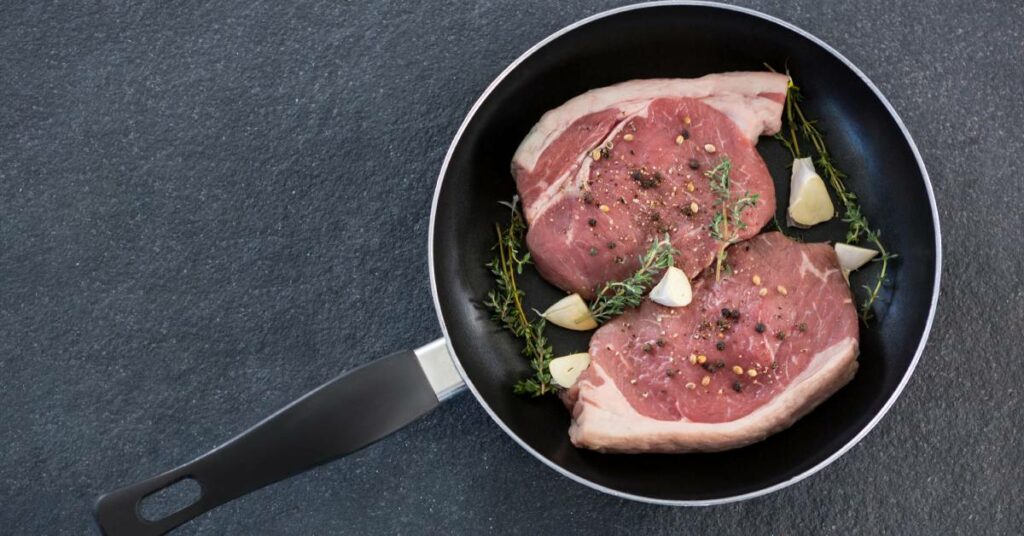Share the post "What Does Calphalon Use for Non-stick? (& Benefits…)"
Calphalon uses PTFE coating for nonstick. PTFE, or polytetrafluoroethylene, is a synthetic polymer with various applications. When it comes to cookware, PTFE is used as a coating because of its nonstick properties. The coating is also resistant to high temperatures and makes cleanup a breeze.

The Benefits of Using PTFE in Calphalon Nonstick Cookware
PTFE is a synthetic polymer that has a variety of applications. When it comes to cookware, PTFE is used as a coating because of its nonstick properties.
Some of the benefits of using PTFE in Calphalon nonstick cookware include:
Prevent Sticking and Makes Cleanup Easy
One of the biggest benefits of using PTFE in Calphalon nonstick cookware is that it prevents food from sticking to the surface of the pan. This makes cooking and cleanup a breeze.
PTFE is also very easy to clean. Even if the food does manage to stick to the surface of the pan, it can easily be wiped away with a damp cloth or sponge.
Heat Resistant and Can Withstand High Temperatures
Another benefit of using PTFE in Calphalon nonstick cookware is that it is heat resistant and can withstand high temperatures. This makes it ideal for cooking at high heat, such as when searing or sautéing food.
PTFE can also withstand temperatures as high as 600 degrees Fahrenheit, making it ideal for use in the oven.
Chemical Resistant And Durable
PTFE is also chemical resistant, meaning it won’t be damaged by chemicals or cleaners. This makes it very durable and long-lasting.
PTFE is also scratch-resistant, so you don’t have to worry about damaging the surface of your cookware.
LEARN MORE: Is Surgical Steel Cookware Safe?
How PTFE Is Applied on Calphalon Nonstick Cookware
PTFE is applied to the surface of Calphalon cookware in a few different ways to make it nonstick such as:
- The first is through a process called fluoropolymer coating. This involves applying the PTFE to the cookware surface and then curing it at high temperatures.
- Another way that PTFE is applied to Calphalon cookware is through a process called plasma spraying. Plasma spraying involves using a plasma torch to spray PTFE onto the surface of the cookware. This method results in a thicker layer of PTFE, which can provide better nonstick properties.
- Once the PTFE has been applied, it needs to be cured. Curing helps to improve the nonstick properties of the cookware and also makes the cookware more durable. Curing is typically done at high temperatures, around 600 degrees Fahrenheit.
- After the cookware has been cured, it is then ready to be used. And that’s how Calphalon nonstick cookware is made!
LEARN MORE: Which Cookware Can I Use With Metal Utensils?
The Risks of Using PTFE Coating in a Calphalon Cookware
While PTFE is a great material for use in Calphalon nonstick cookware, there are some risks associated with using it.
May Break Down at High Temperatures
One of the biggest risks of using PTFE is that it may break down at high temperatures. If the cookware is heated to too high of a temperature, the PTFE coating can begin to break down and release fumes.
These fumes can be harmful if inhaled, so it’s important to use caution when cooking with PTFE-coated cookware.
May Leach Chemicals Into Food
Another risk of using PTFE is that it may leach chemicals into food. This can happen if the cookware is heated to too high of a temperature or if the food is left to sit in the cookware for too long.
In general, it’s best to avoid using PTFE-coated cookware if you are pregnant or breastfeeding, as the chemicals may be harmful to the developing fetus or baby.
PTFE Coating and Health
While polytetrafluoroethylene (PTFE) cookware has been used since the 1960s, its safety has been a point of contention in recent years.
The majority of the debate has focused on a compound known as perfluorooctanoic acid or PFOA. This acid is used to manufacture a variety of fluoropolymers, including PTFE.
In 2016, the U.S. Food and Drug Administration (FDA) released a report concluding that there was no evidence that PTFE-coated cookware posed a health risk when used as intended.
The FDA’s report is based on data from several studies that have looked at the safety of PTFE-coated cookware.
These studies have found that PTFE coatings are stable at high temperatures and do not leach harmful chemicals into food.
While the debate surrounding the safety of PTFE-coated cookware is ongoing, the available evidence suggests that these products are safe to use.
If you have any concerns, it’s best to consult with your doctor or qualified healthcare professional.
LEARN MORE: Is Marble Coated Cookware Safe?
How to Take Care of Calphalon Nonstick Cookware for Longevity
Even though PTFE is a durable material, there are still some things you can do to extend the life of your Calphalon cookware.
- One of the best ways to care for your cookware is to use it only at moderate temperatures. While PTFE can withstand high temperatures, it’s best to avoid using it at these temperatures on a regular basis.
- It’s also important to avoid using metal utensils on the surface of the cookware. These can scratch or damage the nonstick coating. Instead, opt for wooden or plastic utensils.
- When cleaning your cookware, avoid using harsh chemicals or cleaners. These can damage the nonstick coating. Instead, opt for mild soap and water or a specially formulated cookware cleaner.
By following these simple tips, you can help ensure that your Calphalon cookware will last for years to come.
LEARN MORE: Is Pampered Chef Cookware Worth the Money?
Conclusion
In conclusion, PTFE is a great material to use for Calphalon nonstick cookware. It is durable, scratch-resistant, and chemical-resistant.
However, you should keep in mind some risks associated with using PTFE-coated cookware written above.

